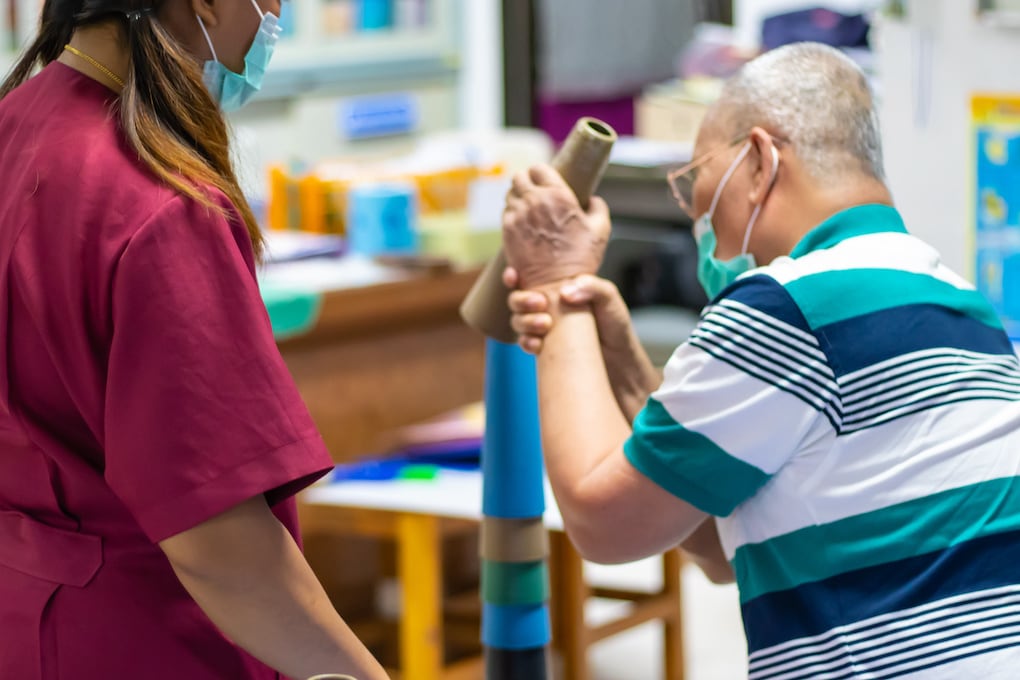As people age, they require more rehabilitation to recoup from surgery, an injury, or even illness—but what does that entail? That doesn’t mean to say only seniors require physical or occupational therapy, but it does become a part of a regular regimen for many. Physical rehabilitation can come in many forms, whether physical exercise, stretching, or other pain management techniques.
Both occupational vs. physical therapy can offer this one-on-one rehab to individuals who need it. Still, they also differ greatly depending on the needs and mobility someone has. So today, we’ll pinpoint the differences, pros, and cons, and reasons why one might choose one over the other—and how each can help.
If you’re considering assisted living for you or a loved one, many facilities offer both, so get informed on what’s out there.
The Similarities Between Occupational vs. Physical Therapy
Occupational and physical therapy share a lot of the same goals to help patients achieve their goals or manage their conditions with the aid of a therapist. These similarities include:
- Improving the quality of life for patients
- Teaching patients how to maintain their health and improve their overall wellbeing
- Both therapies may treat similar conditions such as chronic pain sufferers or those with other mobility issues (post-surgery, illness, aging, injury)
- They share a similar design and structure in offering hands-on therapy specifically catered to patient needs
- Similar stretches, exercises, or techniques may be applied in both occupational and physical therapy
- Both types of therapists set goals and track the progress of results to see if therapy is bettering one’s condition
What Does an Occupational Therapist Do?
An occupational therapist helps people regain mobility and flexibility to make daily tasks easier. They work with a patient to create an individualized treatment plan that can include:
- Helping the patient regain daily skills they’ve lost, such as bathing and grooming
- Regaining fine motor skills and improving flexibility
- Teaching how to use adaptive equipment if needed
- Giving support for mental health conditions
- Promote independence
- Educate caregivers on OT methods and ways to help their patients or family members thrive
Occupational therapy is essential to anyone with disabilities or is recovering from an injury, illness, or surgery. Occupational therapy can also help older adults recover and manage conditions like arthritis to avoid further disability.
What Does an Occupational Therapy Session Look Like?
There is a wide range of methods, techniques, and therapies involved in occupational therapy. A session with a therapist might involve any of the following:
- Relearning how to perform daily tasks like dressing, eating, and bathing
- A home or workplace assessment to determine how to make it easier to navigate
- Learning the proper way to safely get in and out of chairs, beds, or the bathtub
- Learning exercises that help increase flexibility
- Education on the proper use of assistive devices like wheelchairs and walkers
- Help with tasks requiring fine motor skills, like writing or zipping a jacket
- Finding ways to reduce and handle stress in one’s life
- Educating caregivers or loved ones how to support someone with these daily tasks effectively

When Would Someone Need Occupational Therapy?
Occupational therapy is for anyone who needs help with the tasks of daily living that have been lost due to an injury, illness, or surgery. The following can all benefit from occupational therapy:
- Older adults recovering from a hip replacement surgery (or other surgeries)
- People needing assistance in regaining independence and mobility after injury
- Those struggling with mental health conditions such as anxiety or depression
- Children with developmental delays, such as autism
- People with hand or joint conditions such as rheumatoid arthritis or carpal tunnel
- People recovering from a stroke
- Those with neurological disorders such as cerebral palsy or multiple sclerosis
- And patients with dementia or Alzheimer’s
- An individual moving from one type of living situation to another, i.e. from an independent home into an assisted living. This is often to assess for safety and functioning in the new home.
Pros and Cons of Occupational Therapy
There are some benefits but also some downfalls of occupational therapy.
Pros of Occupational Therapy:
- Can help improve the quality of life for patients
- Can be very helpful in regaining skills to live independently
- Help treat mental health conditions
- Educating caregivers is a benefit
Cons of Occupational Therapy
- Can be costly
- Therapy might not be available in every location
What Does a Physical Therapist Do?
A physical therapist helps the patient regain movement and function of their muscles, joints, ligaments, or bones. They usually focus on physically moving a person’s body to help improve flexibility, strength, coordination – but they also incorporate exercises that can be done at home (like simple exercises or stretches).
Physical therapists may only be needed for a temporary amount of time, particularly for those recovering from an injury—or they may offer weekly therapy for consistent pain management. Either way, physical therapists work closely with individuals to safely recover from injury and aid in building up muscle to prevent future injuries as well.
Without proper physical therapy, patients can get scar tissue build-up, chronic sore muscles or joints, and even risk re-injuring themselves by not properly exercising the area. The goals of a physical therapist include:
- Decreasing pain and increasing mobility
- Improving range of motion and strength
- Injury prevention or keeping the condition from worsening
- Teaching patients how to stretch and exercise safely on their own
- Speeding up the recovery process which can be prolonged by not doing the proper therapy
What Can One Expect From a Physical Therapy Session?
Physical therapy is not a one-size-fits-all sort of treatment. Every session can be different based on the needs and abilities of the individual. But, some of the therapies or techniques you might get from a physical therapist include:
- Exercises targeted to the injured or painful area, plus regular exercise to increase overall mobility and flexibility
- Stretching techniques
- Hands-on manipulation of the area with the aid of the Physical Therapist
- Hot or cold compresses to alleviate inflammation and swelling—essential to loosening up tight muscles to prevent injury
- The therapist may massage the area before beginning the session
- Ultrasound technology and therapy can help break up scar tissue within the body at the point of injury
- Electrical stimulation before a massage can activate the area making it more limber and loose before stretches and exercises

When Would Someone Need Physical Therapy?
Physical therapy can be helpful for many things, from minor injuries to extensive surgeries and chronic pain issues. The following are all areas where physical therapists provide their services:
- Sports injuries or other trauma to the body (this can include sprains, strains, fractures)
- Older adults who need assistance with mobility and exercise
- Post-surgery recovery patients
- Patients recovering from cardiac events like strokes or heart attacks
- Those suffering disabilities due to illness such as Parkinson’s disease or lupus
- People with chronic pain conditions such as fibromyalgia
- In children, physical therapy can help treat issues such as cerebral palsy, developmental delays, and torticollis (a condition that causes the head to tilt constantly)
- Patients who have arthritis or other joint pain
- Learning stretches and exercises to maintain independence and flexibility as we age
- Recovery from cancer treatments or stroke
- Therapy for lung or heart conditions
Pros and Cons of Physical Therapy
There are some benefits but also some downfalls of physical therapy.
Pros of Physical Therapy:
- Help people recover from injuries much quicker than if they did not have any therapy
- Help with chronic pain management
- It can help prevent future injuries from occurring
- Patients learn how to do exercises and stretch on their own, so they can consistently get better every day
Cons of Physical Therapy
- It can be expensive, depending on insurance coverage
- Big time commitment—sessions might be as frequently as a few times a week
- Not everyone responds well to physical therapy. Some people may feel worse after a session
- They can’t always do exercises or stretches at home because they require special equipment

Where Can Occupational or Physical Therapy be done?
The best thing about occupational and physical therapy is that it can be done just about anywhere. But for the most part, you can get therapy at any of the following places:
- Outpatient clinics
- Home health agencies (OT/PT can be provided anywhere a patient is living when under a home healthcare agency)
- Schools
- Fitness centers
- Inpatient facilities, such as hospitals and nursing homes
- Mental health facilities
The benefits of both therapies are immense for anyone who is recovering from an injury, dealing with chronic illness, or wants to maintain some mobility as they age. It is an investment in your health maintenance, but the benefits of living pain-free are something money can’t buy.
If you or a loved one are looking for a senior living community that offers both occupational and physical therapy options—reach out to Sunflower Communities today!

